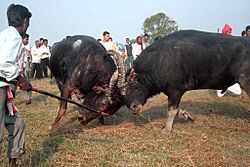Magh Bihu facts for kids
| Magh Bihu | |
|---|---|

A Buffalo fight held at Ranthali, in Nagaon District of Assam, on the occasion of Magh Bihu
|
Magh Bihu (pronounced Maagh Bee-hoo) is a fun harvest festival. It is also known as Bhogali Bihu, which means "festival of eating and enjoyment." People in Assam, a state in North-East India, celebrate it. This festival marks the end of the harvesting season. It usually happens in the month of Magh, which is around January or February.
During Magh Bihu, people light a big bonfire called a Meji. This is a special way to end the harvest and offer prayers. The festival has grown from different cultures, including the Tibeto-Burman and Indo-Aryan traditions.
Contents
What Happens During Magh Bihu?
Magh Bihu is a time for big feasts and bonfires. Young people build temporary huts. These huts are called Meji and Bhelaghar. They are made from bamboo, leaves, and thatch.
People eat the special festival food inside the Bhelaghar. The next morning, these huts are burned down. The celebrations also include traditional Assamese games. One popular game is tekeli bhonga, which means pot-breaking. Another exciting event is buffalo fighting.
Magh Bihu celebrations begin on the last day of the month before, called "Pooh." This is usually January 14th. The night before, January 13th, is called "Uruka." On Uruka, people gather around a bonfire. They cook a big dinner and have a lot of fun together.
During Magh Bihu, people in Assam make many tasty rice cakes. Some popular ones are Sunga Pitha and Til Pitha. They also make sweet treats from coconut called Laru.
Uruka: The Bihu Eve
The first day of Magh Bihu is known as Uruka. This word comes from the Deori-Chutia language. It means "to end," showing the end of the harvest season. On this day, women prepare lots of food for the next day. They make items like Chira, Pitha, Laru, and curd.
A big feast called Bhuj is held at night. Many local groups make their own rice beers for this feast. For example, the Chutias make Chuji, and the Bodos make Zou. The Uruka feast can be a family meal or a big community gathering.
After the feast, the Uruka night continues. People often stay in the Bhelaghar huts built in the fields. Village youth might spend the night there. They keep warm by the fire and enjoy the festive atmosphere.
Magh Bihu Day: Celebrations and Rituals
The main day of Bihu starts very early in the morning. A special ceremony called "Meji" takes place. Bonfires are lit in the fields. People pray to their ancestors for good luck and blessings.
The word Meji comes from the Deori-Chutia language. It means "ancestral gods fly away with the fire." This shows how people honor their ancestors. The bonfires are usually made from firewood, green bamboo, hay, and dried banana leaves.
It is a tradition for people to take a bath before lighting the bonfire. The ritual of Meji Jwaluwa (firing the Meji) is very enjoyable. People offer various foods to the Bhoral (granary) and Meji. These offerings include Chicken, rice cakes, rice beers, Chira, Pitha, and curd.
At the end of the day, the Bhelaghar huts are also burned. People then eat a special mix called Mah-Karai. This is a roasted mix of rice and black gram. For breakfast and lunch, people enjoy many traditional dishes. These include curries made with Fish, Chicken, Pork, Duck, and Mutton. These are eaten with Rice and Rice Beer.
The ashes from the Meji and Bhelaghar bonfires are used in gardens and fields. People believe this helps the plants grow better.
Other Festivals Like Magh Bihu
There are other festivals in Assam and Arunachal Pradesh that are similar to Magh Bihu. The Kacharis, who are part of the Assamese community, have similar customs. On the seventh day of Magh Bihu, they clean their cooking tools. They also offer fowls to their God, Bathou. They go singing from house to house and collect food. They also build and burn Bhelaghars like others.
The Khamti people also have a bonfire tradition. They observe it on the full moon day of the Magh month. This tradition is connected to Buddha. It is thought that the Khamtis adopted this ritual from local people a long time ago.


